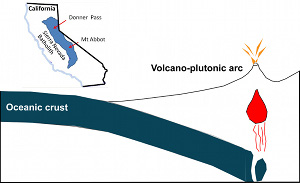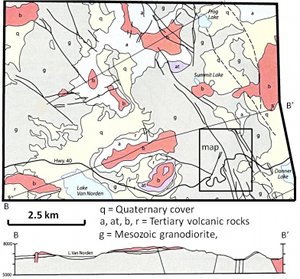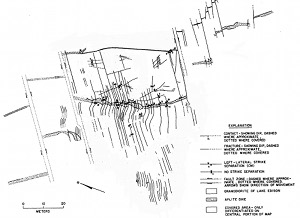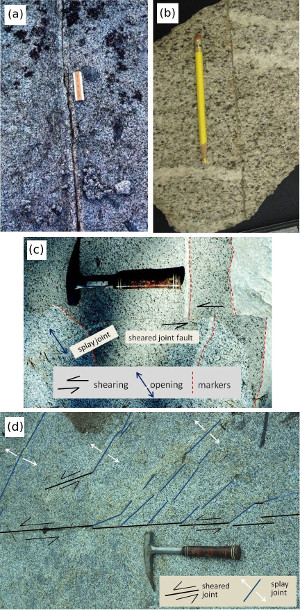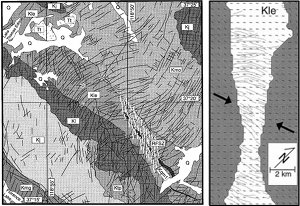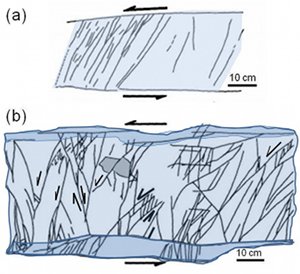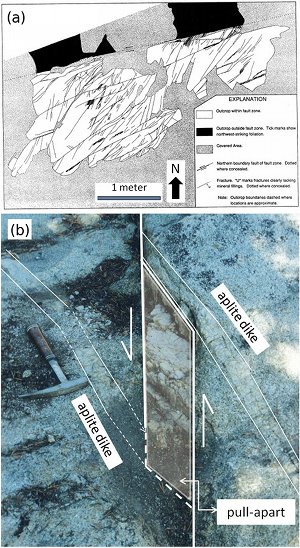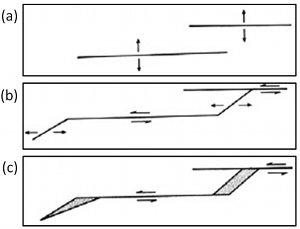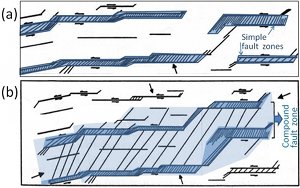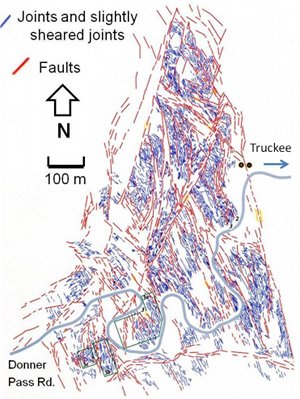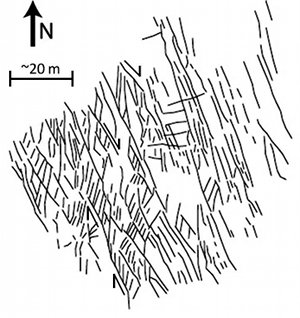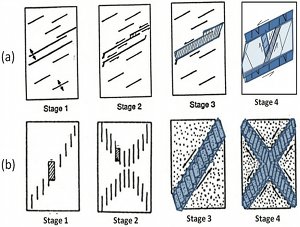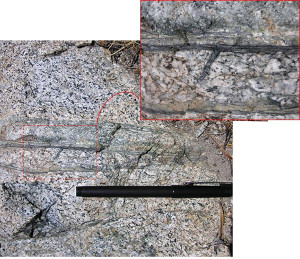| |||||||
|
|
|||||||
|
|
|||||||
| Fractures in Sierra Nevada, CA, USA | |||||||
|
The Sierra Nevada batholith in California is defined primarily by a Mesozoic volcanoplutonic arc (Figure 1) which includes a series of granitic or granodioritic intrusions as well as volcanic rocks formed in an oblique convergent plate boundary with a right-lateral component of strike-slip motion during the Mesozoic time (Saleeby, 1981). Most of the older volcanic rocks were eroded away but the remnants of some younger volcanic rocks of Tertiary to Quaternary age can still be found particularly along the eastern Sierra Nevada (Figure 2). The data presented in this case study come from the Donner Pass (Figure 2) and Mt Abbott (Figure 3) areas (for location see inset in Figure 1). There, the glaciated surfaces of the Mesozoic intrusive rocks provide excellent opportunities for observing joints and their infillings, veins (Figure 4a) and the products of their shearing, faults (Figure 4b). The photographs and maps in Figures 4c, and d show examples of splay fractures. The occurrences of widespread strike-slip faults (Lockwood and Moore, 1979) as well as dip-slip faults (Hudson, 1951; Burnett and Jennings, 1962) in the batholith have been known for a long time. Lockwood and Moore (1979) called the strike-slip faults as microfaults since they have offsets ranging from millimeters to approximately one hundred meters in the Mt Abbott quadrangle. There, these authors identified two sets of faults: One N to NE trending right-lateral set and another E to NE trending left-lateral set. In their words, these two sets form a 'conjugate' pattern and define an overall extension consistent with the Basin and Range extension direction. Hudson (1951) in his cross section showed hundreds of meters of apparent vertical offsets of the Tertiary volcanic rocks along northwesterly trending faults in the Donner Pass-Truckee area (Figure 2). The above mentioned faults in the Sierra Nevada, particularly those in the Mt. Abbott quadrangle have attracted considerable attention since early 1980s primarily for the purpose of understanding the mechanics and mechanisms of jointing and development of strike-slip faults from shearing of these joints in granitic intrusions. An incomplete list of these investigators includes Segall and Pollard, 1980; Segall and Pollard, 1983; Segall, 1984; Segall et al., 1900; Martel et al., 1988; Martel, 1990; Burgmann and Pollard, 1992; Bergbauer and Martel, 1999; Pachell et al., 2003; Ritz, 2013; Ritz and Pollard, 2013; and Nevitt et al., 2014. Based on the field relations together with the geochronology of hydrothermal mineral assemblages in fractures and the altered host rock, Segall et al. (1990) concluded that the joints and the strike-slip faults due to the shearing of the joints at the Mt. Abbott area formed between 85 and 79 Ma, soon after the host pluton was emplaced. Bergbauer and Martel (1999) supported this notion using thermoelastic models to determine potential principal stress orientations at the time of the plutons' cooling and compared them with the observed dominant joint orientations (Figure 5a, b). Most if not all the joints in the granodioritic rocks of Mt. Abbott quadrangle are filled by various precipitants, commonly by quartz and epidote (Figures 4a, b, c, d). Although some of the original veins are still undeformed (for example, Figure 4a), a great majority of them has been sheared. The presence of sheared joints in the same orientation as nearby fractures with only opening displacement discontinuity has been taken as evidence for opening mode fractures as the origin of the faults (Segall and Pollard, 1983). Additional evidence is the highly sheared texture of the infill in thin sections, which can be seen under a simple petrographic microscope. Passive markers in the host rock such as aplite dikes show offsets when crossed by faults (Figure 4b and c). However, the most common evidence is the presence of an opening mode joint or vein at or near the tips of a fracture at an acute angle to it (Figures 4c and d) or a younger joint set with an acute intersection angle to the older one (Figure 4d). These are called splay fractures, kink fractures, or wing cracks and more information about them can be found via the link, Splay Joints, under Joints and Structures on the homepage of this knowledgebase. It is common that splay fractures are geometrically connected to the tips of shear fractures and their segments (Figure 4d). However, a casual observer should keep in mind that every splay fracture initiates from a point at or near the tip of a shear fracture but the surface of exposure does not necessarily contain that point. Once initiated, a splay fracture can propagate in all directions and sometimes it may intersect the shear fracture well beyond it's apparent tips at a different horizon. Martel (1990) proposed that some splays in the Mt. Abbott area are related to the tip lines of slip patches along a given shear fracture or fault. However, it is likely that slip patches at the scale of the observations are related to some physical asperities and fine-scale geometric complexities along the original joints or incipient sheared joint surfaces (Ritz, 2013). Another factor influencing the intersection between a shear fracture and a splay fracture which initiated from a different shear fracture nearby (Figure 6a). In this case, there is little to constrain the termination point of a splay fracture. So, care should be taken in interpreting the initiation and termination of splay fractures between two parallel shear fractures. Some recent experimental and theoretical results indicate that tensile cracks in more-or-less splay fracture orientation may occur along one side of a dynamic rupture with extremely high propagation velocity (Griffith et al., 2008; Ngo et al., 2012) and along faults with rough surfaces (Dunham et al., 2011). It is possible that some of off fault splays may have been generated by the so called super shear events. Figures 6a, b are maps showing progressive development of sheared joint-based faults in the granodioritic rocks of the Mt. Abbott quadrangle from a simple case to gradually more complex cases. Segall and Pollard (1983) and Martel et al. (1988) referred to these progressive forms as simple and compound fault zones, respectively. Both types have bounding faults which accommodate most of the slip. The compound fault zones have various generations of splays at the central parts formed by sequential shearing of the first order (initial) splays. It is possible that discontinuous echelon joints may be connected by splay joints or veins when sheared (Figure 7a). Large accumulation of opening across the stopovers between echelon sheared joints or veins are called pull-aparts (Figure 7b) which are typical structures distributed along brittle faults in highly rigid rocks. Figures 8 and 9 includes a series of diagrams based on the field maps some of which are presented above. 8(a) depicts initial short joint commonly adjacent to other joints. When sheared, the neighboring joints are connected by splays (Fig. 8b). Further dilation of the joints lead to thick veins and in some cases rhombohedral pull-aparts filled by quartz and epidote. Closely spaced highly overlapped or parallel joints, when sheared, are connected by a series of splays at an acute angle forming simple fault zones (Figure 9a). In an hierarchical manner, simple fault zones may be connected by various generations of splays to form compound fault zones (Figure 9b). Figure 10 is a structural map of an area between the town of Truckee and Donner Pass, west of the Lake Tahoe area. In contrast to the joints in the Mt. Abbott quadrangle, most joints in this area are barren. Even though the basic mechanism of faulting is the same as shown in Figure 11, which is sequential shearing of initial joints, splaying and shearing of the splays, the map represents a more complex deformation history resulting in several sets of faults trending approximately N-S, NE-SW, NW-SE, and E-W. This case study shows that faults and related joints in granitic rocks may be very complex due perhaps to multiple stages of inversions. In this particular case, the overprinting Basin and Range type younger deformation over the Mesozoic strike-slip faulting may be responsible for such a complex fault and joint patterns. Figure 12 includes two series of conceptual diagrams (a and b) summarizing fault formation in granitic rocks by opening mode fracturing (jointing) and shearing of the joints based on the field and laboratory models, respectively. The fundamental processes underlying these models are initial sub parallel joints dividing the rock into thin rectangular rock slabs, the rotation and shearing of which result in the formation of fault zones in various orientations. The pattern of the faults produced in the laboratory is commonly referred to as 'conjugate'. The pattern of the field based model in Figure 12 (a) is more complex. It includes multiple faults some of which may be called 'pseudo conjugate or apparent conjugate'. It has also been reported that pseudotachylite melts (Figure 13) occur along some faults and infills of some fractures in diagonal orientation to the faults (Griffith et al., 2008) indicating local melting associated with frictional slip with high propagation velocity (supershear) and local injection into the related splays and perhaps into other fractures not directly related to the melt generating sliding. | |||||||
| Reference: |
|||||||
| Aydin, A., Muller, J.R., Bergbauer, S., Eichhubl, P., Du, Y., Du Bernard, X., 2002 Bergbauer, S., Martel, S.J., 1999 Burgmann, R., Pollard, D.D., 1992 Burnett, J.L., Jennings, C.W., 1962 Dunham, E.M., Belanger, D., Cong, L., Kozdon, J.E., 2011b Griffith, W.A., Di Toro, G., Pennacchioni, G., Pollard, D.D., 2008 Hudson, F.S., 1951 Lockwood, J.P., Moore, J.G., 1979 Martel, S.J., Pollard, D.D., Segall, P., 1988 Martel, S.J., Pollard, D.D., 1989 Martel, S.J., 1990 Martel, S.J., Boger, W.A., 1998 Nevitt, J., Pollard, D.D., Warren, J., 2014 Ngo, D., Huang, Y., Rosakis, A.J., Griffith, A.A., Pollard, D.D., 2012 Pachell, M.A., Evans, J.P., Taylor, W.L., 2003 Peng, S.S., Johnson, A.M., 1972 Renshaw, C., Scholson, E.M., 2001 Ritz, E.M., Pollard, D.D., 2013 Ritz, E.M., 2013 Saleeby, J., 1981 Segall, P., Pollard, D.D., 1983 Segall, P., 1984 Segall, P., McKee, E.H., Martel, S.J., Turrin, B.D., 1990 |
|||||||
|
Readme | About Us | Acknowledgement | How to Cite | Terms of Use | Ⓒ Rock Fracture Knowledgebase |
|||||||
